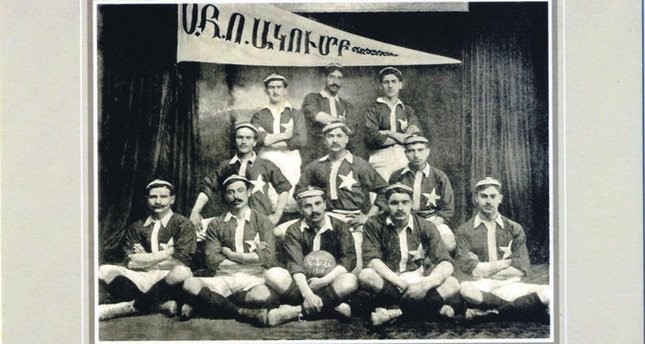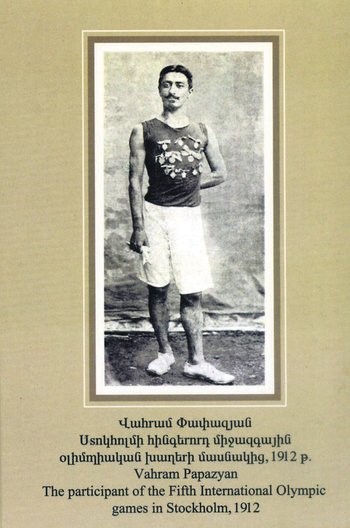.jpg)
THE MEMORIES OF ARMENIAN OLYMPIANS IN THE OTTOMAN EMPIRE
Ottoman Armenians distinguished themselves in sports during the early 20th century with successful sportsmen representing the empire at the 1912 Stockholm Olympics
Armenians who have lived in eastern Anatolia since ancient times were exposed to discrimination in the Byzantine Empire era due to the sectarian differences that existed between them and their Byzantine fellows. Armenians were not even allowed to settle in the west, but with the arrival of the Turks in Anatolia, they were allowed to move westward and spread throughout, where they established a community in almost every city.
Although in the Ottoman Empire, politics was controlled by Muslims, non-Muslims were allowed to practice their religion and join social and economic life with an equal status to Muslims. Differences were welcomed and even protected by the empire. Non-Muslims might experience the arbitrary oppression shown by executives, but belonging to a non-Muslim community did not pose a reason for discrimination or oppression.
Non-Muslim communities were not considered as minorities by the Ottomans since there were no minority or majority groups in the empire, but components that constituted it. The word "minority" belongs to 20th century nation-state terminology and refers to a community that opposes the majority.

Under the Ottoman colors
Ottoman Armenians had an important place in the economy and culture thanks to their skills in various handicrafts. A number of national artists from architects to composers were brought up from the Armenian community during the Ottoman reign. Nonetheless, most people are not familiar with the success of Armenian sportsmen and their victories. The Armenian sportsmen who attended to the Olympics with their own money became the first athletes to represent the Ottomans at these games.
Starting from the last quarter of the 19th century, modern sports were on the rise among the Ottomans as well as in the rest of Europe. Foreigners and non-Muslims in particular took the initiative. In the early 20th century, Turkish, Greek, Armenian and Jewish sports clubs were established in the Ottoman Empire. There were 17 sport clubs founded by the Armenians in Istanbul alone. Sport clubs owned by Armenians were run in almost all Anatolian cities.
Istanbul-native Armenian Shavarsh Krissian (1886-1915) played an important role in the development of modern sports. Krissian was educated in physical training in Europe and he dedicated his life to the development and recognition of sports in the Ottoman Empire. He published a magazine called "Marmnamarz" (Physical Education) and worked as a teacher in various schools. Following his meetings with the British, French and the Americans, he secured the participation of two Robert Collage students, Vahram Papazyan and Mıgırdiç Mıgıryan, at the 1912 Olympic Games.

Two young Armenians
These two young athletes represented the empire in the athletics category at the 5th Olympic Games held in Stockholm. Mıgıryan competed in the pentathlon, heptathlon, hot put, javelin and discus in a time that the Athletics Federation had not yet been established. Papazyan competed in the Men's 800 meters and 1500 meters races. Both athletes represented their country with their uniforms bearing the Ottoman coat of arms, sewed by the Ottoman ambassador to Stockholm himself.
Papazyan resided in Istanbul's Bebek quarter, working as a newspaper distributor. He used to run and distribute the papers early in the morning and then head to school. Mıgıryan was the child of a wealthy family interested in sports. The money that was needed to send these two athletes to Stockholm was collected via a country-wide campaign launched by the Ardavazt Club. The members of the Ottoman court even went to Arnavutköy theater to see the play "Fedakar Gemici" (Devoted Sailor), starring Papazyan, to support the cause. In the end, two athletes managed to collect enough money to make it to Stockholm for the Olympics.
Walking on the streets of Stockholm, Papazyan noticed that the streets and important buildings were adorned with the flags of all the countries participating at the Olympics, but there was no Ottoman flag. He hopped in a cab and headed to the Ottoman embassy.
After he was received by the ambassador, Papazyan said, "Stockholm is depressing to me and I would like to return to my country carrying my suitcases. All of Stockholm is adorned with foreign flags, but not the Turkish flag, and this is an insult to me and my country. I will only stay here if measures are taken so the flag of my country flies among all the others."
With the help of the ambassador, who was shocked to witness the patriotism of an Armenian, the streets of Stockholm were decorated with Turkish flags within a couple of hours.
Moving forward, Mıgıryan was successful in the discus and pentathlon, in which he came in fourth. However, Papazyan, who was leading Men's 1,500-meter race, fainted and fell down on the home stretch, losing the title.
At the same time, Selim Sırrı Tarcan, a prominent figure of Turkish sports and a member of the Olympic Committee as well as the member of the Committee of Union and Progress (CUP), expressed his unhappiness that there was no "Turkish" sportsman representing the Ottomans.
Upon this comment, Krissian penned a blistering answer in his magazine and accused Tarcan of discrimination, "There are people writing articles thinking that we cannot understand Turkish writing. Two Armenians went to Stockholm. These two people were there not because they are Armenians but because they are Ottomans. Their uniforms feature the Ottoman crescent. They tried to advance the Ottomans in sports. Those who watched them compete did not applause because they are Armenians, but because there are Ottomans. Why don't you speak the names of these two Ottomans? Unlike common belief, the Ottoman State does not belong only to Turks. Armenians geared up with weapons in the Balkans to protect the Ottomans as well."
Armenian influence in football
With the efforts of Krissian, sports organizations welcomed hundreds of Armenian sportsmen in the Ottoman State between 1911 and 1914. Krissian's magazine published articles to increase interest in sports among the Ottomans. Furthermore, Krissian penned and published a book on scouting as well.
Krissian was arrested with other Armenian intellectuals on Apr. 24, 1915 and he was later murdered in Çankırı. During the deportation of hundreds of thousands of Armenians to Syrian lands in 1915 by the Young Turks, who seized power in 1908 and brought the Ottomans to the breaking point with their policies of discrimination. Many Armenian sportsmen died on the road to exile.
Papazyan was enlisted right after the Olympics. He fought against the enemy on the Gallipoli front as a telegraph officer. Papazyan who survived the war, moved to Beirut and later wrote his memoires.
For a long time, due to the 1915 disaster and its negative image, awkward moments ensued when Turkish and Armenian sportsmen encountered each other in sports competitions due to the possibility of provocation. In a 1930 match that Turkey played against Syria, five Armenian sportsmen, who settled in the country following the deportation, were excluded. On the other hand, there were Armenian sportsmen that made Turkey more popular in the sports scene. Known as "Tekneci Garbis," Garbris İstanbulluyan played in Vefaspor and helped win a national football match in Zurich in 1953 netting a blazing goal to lead Turkey to victory.
Önceki Yazılar
-
THE FIRST UNIVERSITY IN THE WORLD WAS FOUNDED BY MUSLIMS3.12.2025
-
WHO BETRAYED PROPHET ISA (JESUS)?26.11.2025
-
IT HAS BEEN MORE THAN 100 YEARS SINCE ITS ABOLITION, BUT... IS THE CALIPHATE BEING REESTABLISHED?19.11.2025
-
GREETINGS TO YOU, O OTTOMAN SANJAK!…12.11.2025
-
ROTHSCHILDS BROUGHT THE END OF THE OTTOMAN EMPIRE!5.11.2025
-
SHEIKH BEDREDDIN, SON OF THE QADI OF SIMAVNA29.10.2025
-
THE ROOTS OF THE ENGLISH POLITICIAN IN TURKEY – THE TRAGIC END OF ALI KEMAL BEY22.10.2025
-
WHERE IS THE RED APPLE?15.10.2025
-
THE ABBASIDS IN ANATOLIA1.10.2025
-
IMAMS AND MUFTIS AS OFFICERS IN THE OTTOMAN ARMY24.09.2025